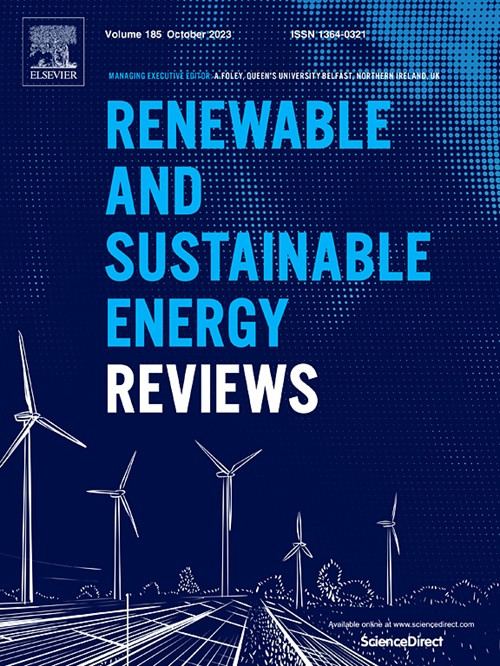从家用太阳能烹饪到机构太阳能烹饪技术的范式转变的批判性分析
IF 16.3
1区 工程技术
Q1 ENERGY & FUELS
引用次数: 0
摘要
太阳能烹饪技术已经发展成为完善和广泛接受的解决方案,在家庭和机构应用。在过去的五十年里,技术进步和成本效益促进了简单的盒式太阳能炊具向大规模社区烹饪系统的转变。然而,由于缺乏单一的主导因素,选择最佳的太阳能烹饪技术仍然具有挑战性。用户必须评估长期采用的能源、经济和环境(EEE)方面的考虑。本研究引入基于生命周期评估(LCA)的选择指数(SI)来指导用户对太阳能烹饪技术做出明智的决策。一项超过25年的能源对比分析显示,盒式太阳能、面板式太阳能和基于pcm的盒式炊具的净能量平衡分别为19.33、23.90和29.62 GJ。而菲涅尔透镜,SK-14, SK-30,舍弗勒和机构太阳能烹饪系统分别达到188.24,216.23,1154.52,3111.67和72411.17 GJ的显著值。经济分析强调了从盒式太阳能的10,662.47卢比到机构太阳能烹饪的1.7173亿卢比的净余额,显示了长期的成本效益。环境效益包括大量减少二氧化碳排放,盒式炊具减少了1.70公吨,而机构太阳能炊具减少了436万吨的排放量。SI值范围从0.64到1.81,证实了机构太阳能烹饪优越的可持续性。研究结果强调了机构太阳能烹饪作为最有效、最经济、最环保的替代方案的可行性,加强了其在实现全球可持续发展目标方面的作用。本文章由计算机程序翻译,如有差异,请以英文原文为准。

A critical analysis of paradigm shifts from domestic solar cooking to institutional solar cooking technologies
Solar cooking technologies have evolved into well-established and widely accepted solutions across domestic and institutional applications. Over the past five decades, technological advancements and cost-effectiveness have facilitated the transformation of simple box-type solar cookers into large-scale community cooking systems. However, selecting an optimal solar cooking technology remains challenging due to the absence of a single dominant factor. Users must evaluate energy, economic, and environmental (EEE) considerations for long-term adoption. This study introduces a Selection Index (SI) based on Life Cycle Assessment (LCA) to guide users in making informed decisions about solar cooking technologies. A comparative energy analysis over 25 years reveals that box solar, panel box solar, and PCM-based box cookers exhibit net energy balances of 19.33, 23.90, and 29.62 GJ, respectively. While Fresnel lens, SK-14, SK-30, Scheffler, and institutional solar cooking systems achieve significantly higher values of 188.24, 216.23, 1154.52, 3111.67, and 72411.17 GJ, respectively. The economic analysis highlights net balances from ₹10,662.47 for box solar to ₹171.73 million for institutional solar cooking, demonstrating long-term cost-effectiveness. Environmental benefits include substantial CO2 reductions, with box cookers preventing up to 1.70 metric tons, while institutional solar cookers reduce emissions by 4.36 million metric tons. The SI values range from 0.64 to 1.81, confirming the superior sustainability of institutional solar cooking. The findings emphasize the viability of institutional solar cooking as the most efficient, economical, and environmentally sustainable alternative, reinforcing its role in achieving global sustainability goals.
求助全文
通过发布文献求助,成功后即可免费获取论文全文。
去求助
来源期刊

Renewable and Sustainable Energy Reviews
工程技术-能源与燃料
CiteScore
31.20
自引率
5.70%
发文量
1055
审稿时长
62 days
期刊介绍:
The mission of Renewable and Sustainable Energy Reviews is to disseminate the most compelling and pertinent critical insights in renewable and sustainable energy, fostering collaboration among the research community, private sector, and policy and decision makers. The journal aims to exchange challenges, solutions, innovative concepts, and technologies, contributing to sustainable development, the transition to a low-carbon future, and the attainment of emissions targets outlined by the United Nations Framework Convention on Climate Change.
Renewable and Sustainable Energy Reviews publishes a diverse range of content, including review papers, original research, case studies, and analyses of new technologies, all featuring a substantial review component such as critique, comparison, or analysis. Introducing a distinctive paper type, Expert Insights, the journal presents commissioned mini-reviews authored by field leaders, addressing topics of significant interest. Case studies undergo consideration only if they showcase the work's applicability to other regions or contribute valuable insights to the broader field of renewable and sustainable energy. Notably, a bibliographic or literature review lacking critical analysis is deemed unsuitable for publication.
 求助内容:
求助内容: 应助结果提醒方式:
应助结果提醒方式:


